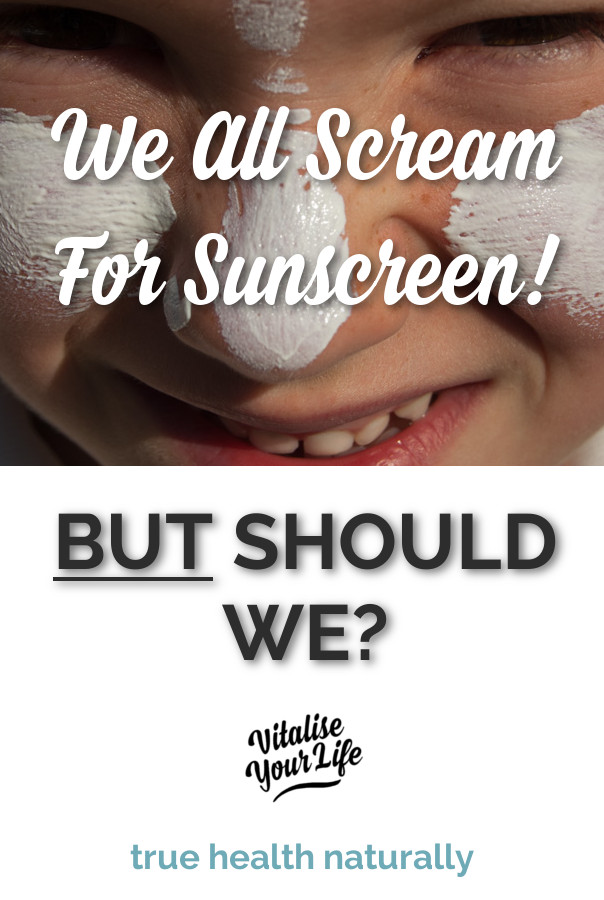We all scream for sunscreen! But should we?
/The Sun & Vitamin D
We have been warned so much about the dangers of the sun that we all know not to get burnt. However, have we gone too far? How much sun exposure do we need to get Vitamin D but not burn our skin? Are the high factor sunscreens always necessary and are they good for us? And why is vitamin D so important?
The sun comes out and we feel compelled by every cell in our body to bask in it, with good reason. The sun's UVB rays help our body make Vitamin D, which is vital for our immune systems, it influences virtually every single cell in our body and is one of nature's most potent cancer fighters. We really cannot underestimate how much we need Vitamin D or how little of it we get, especially in northern latitudes.
Vitamin D is actually a steroid hormone. It is created by the sun's UVB rays, that are absorbed by our skin, and converted into Vitamin D with the help of cholesterol.
min D interacts with our DNA and is directly involved with influencing over 200 of our genes.
At least a dozen studies have noted a strong link between multiple sclerosis (MS) and vitamin D deficiency.
Researchers in New Zealand recently highlighted the importance of vitamin D in the prevention of gastrointestinal diseases, including cancer.
Having a vitamin D level below 20 ng/mL may raise your risk for depression by as much as 85 percent.
It is estimated that there are over 1 billion people worldwide with inadequate Vitamin D levels.
What's wrong with sunscreen?
We are repeatedly told to cover ourselves with sunblock and protect ourselves from the cancer-inducing harmful rays of the sun. We cover our bodies and our children's bodies with easy to apply, high factor, sun tan lotion so that it will protect us from this potential harm. However sunscreens block 98% of the UVB rays that create Vitamin D and they contain lots of chemicals, some of which are known carcinogens. This can be dangerous because our skin can absorb everything that is placed on it. The pores of our skin open when we get hot so that we can sweat to cool off; as this happens the sunscreen's chemicals enter the top layers of skin and can then penetrate through to the capillaries and eventually into the blood stream.
What are these chemicals?
All the sunscreen ingredients listed below are chemicals known to cause harm and are linked to various diseases, not least of which are many types of cancer. What is more worrying is that sunscreen sprays are especially harmful to children as the micro particles can be inhaled and can damage their lungs and get absorbed into their blood.
menthyl anthranilate
octocrylene
methoxycinnamate
parabens
pthalates
synthetic musks
retinal and retinol palmitate (vitamin A derivatives)
PABA
octyl salicylate
oxybenzone
cinoxate
dioxybenzone
phenylbenzimidazole
homosalate
Here is a link to a great guide on sunscreen chemicals.
SAFE sun exposure is the answer
We need the sun. Sunlight triggers the production and release of hormones, like serotonin - responsible for mood and mental focus; and melatonin - which is responsible for normal, healthy sleep patterns. Moderate sunlight has anti-cancer benefits which are most likely related to vitamin D production. Many skin conditions can be helped by exposure to sunlight: psoriasis, eczema, jaundice and acne. And there is preliminary research showing that sunlight can help several other conditions like rheumatoid arthritis and inflammatory bowel disease.
As a general guide, exposing large portions of your skin, like your arms, legs, chest and back, to the sun for 10 to 20 minutes between 10 am and 2 pm will allow your body to reach saturation point for vitamin D. Any more sun exposure is actually bad for us, causing heat stroke, sunburn and dehydration. Here is a link to a more comprehensive guide on safe sun exposure.
If you want to continue sunbathing then apply a natural sunscreen, here is a recipe for making your own. Otherwise, cover up with clothes or stay in the shade.
You can also build up your exposure to the sun gradually so that your skin adjusts and creates more melanin to protect your skin from within.
One option is to find a safe tanning bed that uses electronic ballasts to create the light, and only have short bursts of a few minutes exposure at a time. This can be useful in the winter months to keep vitamin D levels up, and can build your melanin levels in the build up to summer.
And...whatever you do, DON'T BURN!
My advice for glowing, summer ready skin:
Eat the rainbow - lots of fresh multi-coloured fruit and vegetables, full of antioxidants and phytonutrients to protect you from the free radical damage caused by sun exposure.
Natural Moisturisers - after a day in the sun, use natural and pure moisturisers like coconut oil, aloe vera gel (great for cooling and healing the skin after sun burn) or make your own moisturiser from natural products.
Skin brushing - this is a wonderful technique. It can help get rid of dead skin cells, improve circulation in the skin, reduce appearance of cellulite, increase the production of fresh, young skin cells and improve uneven skin tone.
Below are a list of links to useful websites, articles and charts from safe sun exposure to how to check your Vitamin D levels:
Natural Sunscreen Products - http://www.jasonnaturalcare.co.uk/best-sun-cream/
Guide to safe sunscreen exposure - http://articles.mercola.com/sites/articles/archive/2009/10/29/how-much-sunshine-does-it-take-to-make-enough-vitamin-d-perhaps-more-than-you-think.aspx
Sunscreen chemicals and their negative health effects - http://www.ewg.org/2015sunscreen/report/the-trouble-with-sunscreen-chemicals/
Sunscreen benefits - http://www.lifehack.org/articles/lifestyle/10-amazing-health-benefits-sun-exposure.html
Vitamin D dosage chart - http://grassrootshealth.net/media/images/chart-serum-level-intake-5-by-3-ngmla-both-charts-single.pdf
A simple, affordable, vitamin D test - http://www.vitamindtest.org.uk/
Do you use sunscreen? If so, which brand?…………







